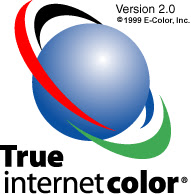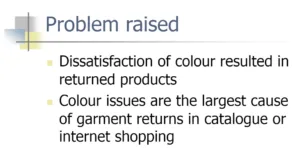Last week, Mike Bailly wrote an interesting article (Who Still Cares About Colour Today?) about the challenges of marketing displays with accurate colour in digital signage and public display applications. In the comments to that article, Ken made the point that accurate colour would be a real advantage in eCommerce. I’m going to, respectfully, disagree.

It’s said that “those that do not learn from history are condemned to repeat it”. So, as an unofficial (and self-appointed!) historian of the display industry, let me point out that accurate colour to help with internet commerce is not a new idea.
Back in the early 1990s, while working for Eizo, the monitor maker, I met Bill Hilliard of a company called Sonnetech. He had a product that he called ‘Colorific’ that was a software app that allowed monitors (then CRT-based) to better match to the colours on printers. He had a successful business selling the software to monitor suppliers to bundle with their displays. He said that he sold 68 million copies of the software to monitor makers.

Gamers Want Better Images
Bill became a friend and over lunch one day at a CeBIT show, I suggested that one of the problems for games developers was that although games depended on dark tones to give the atmosphere they were looking for, the variability of gamma curves and monitor settings often meant that the detail was not visible. Being the entrepreneur he was (and still is, according to his LinkedIn profile!), he took the idea and ran with it to create in 1998 a technology called 3Deep which, like Colorific, allowed the user to tweak the monitor to a controlled point to get the image as intended by the developer. (a concept that is these days being pursued in the TV set market by companies such as Portrait Displays).
(As a geek, it was a great moment for me when my idea ended up as a feature in Windows after Hilliard convinced Microsoft to include it in DirectX).
3Deep was widely supported and adopted by by Samsung, Creative Labs, STB and others.
Colour Differences on the Internet
After developing software for better colour control when printing and when playing games, in 1999, Sonnetech reported market research that suggested that 76% of frequent Web surfers felt that colour consistency was “somewhat to extremely important”. Meanwhile, almost 15% of shoppers surveyed reported having returned items because the on-line colour did not match the actual product that was delivered.

Of course, the company had a solution to this problem and the next development in the company’s growth was a combination of ‘True Internet Color’ (for the clients) and ChromaServe for web servers that between them gave much more consistent colour on users’ displays when web browsing.
Now, Bill was a great salesman and the key benefit that he was selling was consistency of colour for etailers. At the time, they were learning how to deal with the challenges of ecommerce and the cost of returns was really hitting the profitability. So, he got a really good response from a number of big firms and the software was rolled out by Akamai.
Hilliard’s company, which was now called E-Color raised $9 million in VC funding in early 2000, just after it announced the first use of the technology by Bloomingdales. J Crew was another supporter. As well as retailers, companies in the supply chain for apparel adopted it. A former CEO of Macy joined the board of directors.
By 2001, E-Color seemed to be on a roll. It claimed to be adding a million users per month and was forecasting that it would have 32 million consumers using its software for ecommerce by 2003.
However, in 2002, LightSurf acquired E-Color and in 2005, that company was acquired in turn by Verisign. And the reality is that today, few consumers have any level of correction or calibration of their monitors.
So why didn’t the technology become a must have? The truth is that for most purposes, calibration doesn’t matter that much and etailers found that the accuracy of colours didn’t make any real difference to the level of returns that they saw. It turns out that it didn’t really matter to buyers whether what they received matched what they thought they had bought. Once customers received the products, they decided if they liked them or not. If they didn’t like them (even if they matched) they sent them back. If they liked them (even if they didn’t match), they kept them.
That meant no financial incentive for the websites and those delivering the content to adopt the technogy, so it died out.
There is no doubt that good colour reproduction would make life easier – we’re in the middle of redecorating our lounge and trying to match colours between different furniture and soft furnishings. It’s not easy, and even though I have a good calibrated display, the reality is that the content on the web really hasn’t been created with a controlled colour pipeline, so online colours rarely get close to the actual textiles and materials. (BR)

